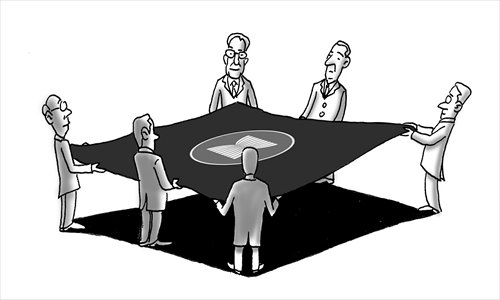ASEAN seeks new economic leverage

Illustration: Liu Rui/GT
ASEAN leaders officially launched the establishment of an integrated economic bloc on Sunday. The ASEAN Economic Community, the first step toward full-scale integration of the 10-state grouping, is hailed as a big push in the creation of a single market with unrestricted flow of capital, goods and labor.
The single market will cover over 600 million people and a combined GDP of $2.4 trillion. After China and India, ASEAN is building another major emerging market in Asia.
The outlook for the market has garnered quite a lot of attention, mostly from a positive perspective. Analysts, observers and media are heavily engaged in discussions about the EU-style community, talking about how much foreign capital will find a role there given the region's massive demand for infrastructure development, how many economic benefits it will bring to the member states, and how big the push will be to help bridge the gap among different members.
But ASEAN's economy is hardly likely to leap onto the fast track after the launch of the economic community. The economic foundation for free flow of goods, capital and labor is shaky. The community might be overshadowed by much bigger free trade zones that include major powers such as China, Japan and even the US.
And the new bloc is not driven by business or trade. It is more like a political move instead of an economic decision. It's tactical rather than strategic. ASEAN so far does not have solid political and economic foundations that can be used to reach a higher level of integration. The economic community is something that can be used by ASEAN to claim greater say in regional and internal affairs.
ASEAN was established as a union of sovereign states. Although it is sometimes compared with the EU, which might be a role model for ASEAN, ASEAN is still disunified. It doesn't have super-national elements, such as laws, currency or policy for labor movement, that can make sure the organization speaks with one voice.
ASEAN was established solely for a political purpose. Southeast Asian countries hope they can play a bigger role in the international community and gain more leverage in global discourse, if they can emerge as a bloc.
However, the trajectory of ASEAN integration has changed since the US poses an assertive attitude toward the Asia-Pacific. The western coast of the Pacific Ocean, including East Asia and Southeast Asia, is bogged down in a struggle for structural stability. As for ASEAN, it faces the threat that strong US involvement, sometimes intervention, is edging ASEAN out in regional affairs.
The US doesn't care much about the significance of ASEAN, which is not a party it wants to speak to. Washington places more importance to its traditional alliance system, which, however, is a distraction to ASEAN. ASEAN finds it increasingly difficult to reach consensus on certain matters because the US is pressuring its allies that are also members of ASEAN.
With the growing influence of multiple players, ASEAN finds itself marginalized. ASEAN's original mechanisms, intended to enhance the organization's leverage in the international community, are being offset by some of the players. Thus, the high-profile adoption of an economic community, which was scheduled to be launched before 2016, is also a publicity tactic to pronounce that ASEAN is still committed to integration, and won't be easily disrupted despite its proximity to major-power rivalries.
Besides the newly initiated economic community, East and Southeast Asia is burdened by too many regional organizations, many of which overlap. The situation reflects the drastic transformation of regional structure in terms of politics, national security and economy.
Many of the organizations are set on countering the others, such as the US-led Trans-Pacific Partnership. Their functions can only work in a limited scope. East and Southeast Asia needs new and profound mechanisms that can represent the needs of every actor. Only under this scenario can the system contribute to the best interests of the region.
ASEAN wants to speak in one voice, but its internal contradictions, along with external distractions, are too large to produce sufficient agreement on many major issues.
With a strategy of pivot to Asia, Washington has clearly displayed its intent to foist its traditional alliance system as the dominant way to control regional affairs, while China, in a continuous effort to promote reciprocity with ASEAN, hopes ASEAN can assume more responsibilities in regional affairs.
ASEAN needs to weigh the influence from major powers, and choose how to balance for the greater good.
The author is a professor at the Guangdong Research Institute for International Strategies. opinion@globaltimes.com.cn